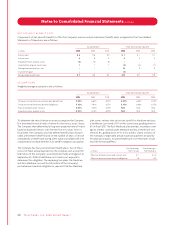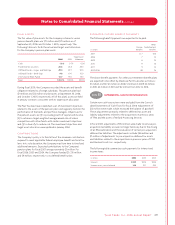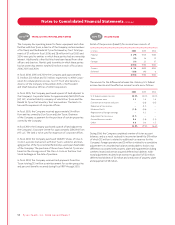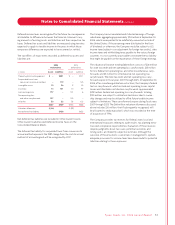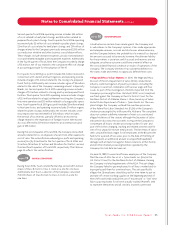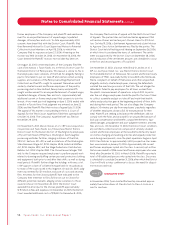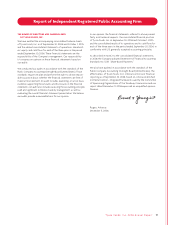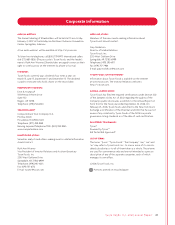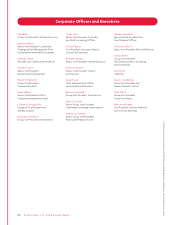Tyson Foods 2006 Annual Report Download - page 57
Download and view the complete annual report
Please find page 57 of the 2006 Tyson Foods annual report below. You can navigate through the pages in the report by either clicking on the pages listed below, or by using the keyword search tool below to find specific information within the annual report.
Second quarter fiscal 2006 operating income includes $45 million
of costs related to beef plant closings and $14 million related to
prepared foods plant closings. Fourth quarter fiscal 2006 operating
income includes $2 million of costs related to poultry plant closings,
$2 million of costs related to beef plant closings, and $19 million of
charges related to the Company’s previously announced $200 million
cost reduction initiative and other business consolidation efforts.
These charges include severance expenses, product rationalization
costs and related intangible asset impairment expenses. Additionally,
in the fourth quarter of fiscal 2006, the Company recorded a charge
of $5 million, net of tax, related to the cumulative effect of change
in accounting principle for the adoption of FIN 47.
First quarter fiscal 2005 gross profit includes $12 million received in
connection with vitamin antitrust litigation, and operating income
includes charges of $3 million related to the closing of a prepared
foods facility. Additionally, net income includes a gain of $8 million
related to the sale of the Company’s remaining interest in Specialty
Brands, Inc. Second quarter fiscal 2005 operating income includes
charges of $2 million related to closing poultry and prepared foods
facilities. Third quarter fiscal 2005 operating income includes charges
of $33 million related to a legal settlement involving the Company’s
live swine operations and $10 million related to closing poultry opera-
tions. Fourth quarter fiscal 2005 gross profit includes $8 million related
to hurricane losses, and operating income includes $1 million in gains
related to plant closings. Additionally, net income includes a non-
recurring income tax net benefit of $15 million, which includes
the reversal of tax reserves, partially offset by an income tax
charge related to the repatriation of foreign income. Net income
also was affected by $19 million related to a tax exempt actuarial
gain of $55 million.
During the second quarter of fiscal 2006, the Company reclassified
amounts related to loss on disposals of assets from other expense to
cost of sales. The reclassification reduced gross profit and operating
income (loss) by $4 million for the first quarter of fiscal 2006, and
$3 million, $8 million, $7 million and $2 million for the first, second,
third and fourth quarters of fiscal 2005, respectively. The table on
page 54 reflects this reclassification.
NOTE 19 CAPITAL STRUCTURE
During fiscal 2006, Tyson Limited Partnership converted 15 million
shares of Class B stock to Class A stock on a one for one basis.
Additionally, Don Tyson, a director of the Company, converted
750,000 shares of Class B stock to Class A stock on a one for
one basis.
NOTE 20 CONTINGENCIES
Listed below are certain claims made against the Company and
its subsidiaries. In the Company’s opinion, it has made appropriate
and adequate reserves, accruals and disclosures where necessary,
and the Company believes the probability of a material loss beyond
the amounts accrued to be remote; however, the ultimate liability
for these matters is uncertain, and if accruals and reserves are not
adequate, an adverse outcome could have a material effect on
the consolidated financial condition or results of operations of the
Company. The Company believes it has substantial defenses to
the claims made and intends to vigorously defend these cases.
• Wage and Hour/Labor Matters: In 2000, the Wage and Hour
Division of the U.S. Department of Labor (DOL) conducted an
industry-wide investigation of poultry producers, including the
Company, to ascertain compliance with various wage and hour
issues. As part of this investigation, the DOL inspected 14 of the
Company’s processing facilities. On May 9, 2002, a civil complaint
was filed against the Company in the U.S. District Court for the
Northern District of Alabama, Elaine L. Chao, Secretary of Labor,
United States Department of Labor v. Tyson Foods, Inc.The com-
plaint alleges the Company violated the overtime provisions
of the federal Fair Labor Standards Act (FLSA) at the Company’s
chicken-processing facility in Blountsville, Alabama. The complaint
does not contain a definite statement of what acts constituted
alleged violations of the statute, although the Secretary of Labor
indicated in discovery the case seeks to require the Company to
compensate all hourly chicken processing workers for pre- and
post-shift clothes changing, washing and related activities and for
one of two unpaid 30-minute meal periods. The Secretary of Labor
seeks unspecified back wages for all employees at the Blountsville
facility for a period of two years prior to the date of the filing of
the complaint, an additional amount in unspecified liquidated
damages and an injunction against future violations at that facility
and all other chicken processing facilities operated by the
Company. No trial date has been set.
On June 22, 1999, 11 current and former employees of the Company
filed the case of M.H. Fox, et al. v. Tyson Foods, Inc. (Fox) in the
U.S. District Court for the Northern District of Alabama claiming
the Company violated requirements of the FLSA. The suit alleges
the Company failed to pay employees for all hours worked and/or
improperly paid them for overtime hours. The suit specifically
alleges that (1) employees should be paid for time taken to put on
and take off certain working supplies at the beginning and end of
their shifts and breaks and (2) the use of “mastercard” or “line” time
fails to pay employees for all time actually worked. Plaintiffs seek
to represent themselves and all similarly situated current and
Ty s on Foods, Inc. 2006 Annual Report55
Notes to Consolidated Financial Statements continued





